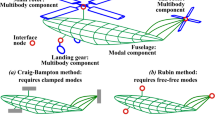Abstract
Different kinds of modal synthesis method have been used widely in dynamic analysis of linear structure systems, but, in general, they are not suitable for nonlinear systems.
In this paper, a kind of modal synthesis techniques is extended to dynamic analysis of nonlinear systems. The procedure is based upon the method suggested in [20], [21], which is applicable to vibration analysis for complex structure systems with coupling attachments but with simplified forms of linear springs and dampers. In fact, these attachments have nonlinear characteristics as those generally known to the cases of nonlinear elasticity and nonlinear damping, e.g., piecewise-linear springs, softening or hardening springs, Coulomb damping, elastoplastic hysteresis damping, etc.. So long as the components of structure are still linear systems, we can get a set of independent free-interface normal mode information but only keep the lower-order for each component. This can be done by computations or experiments or both. The global equations of linear vibration are set up by assembling of the component equations of motion with nonlinear coupling forces of attachments. Then the problem is reduced to less degrees of freedom for solving nonlinear equations. Thus considerable saving in computer storage and execution time can be expected. In the case of a very high-order system, if sufficient degrees of freedom are reduced, then it may be possible for the problem to be solved by the aid of a computer of ordinary grade.
As the general nonlinear vibration of multiple degrees of freedom systems is quite involved, in general, the exact solution of a nonlinear system equations is not easy to find, so the numerical method can be adopted for solving the reduced nonlinear equations to obtain the transient response of system for arbitrary excitations.
Similar content being viewed by others
References
Hurty, W. C.,Vibration of structural systems by component mode synthesis, Journal of the Engineering Mechanics Division, ASCE, Vol. 86, (Aug. 1960), 51–69.
Hurty, W. C.,Dynamic analysis of structural systems using component modes, AIAA Journal, Vol. 3, (April 1965), 678–685.
Serbin, H.,Vibration of composite structures, Journal of the Aeronautical Sciences, Vol. 12, No. 1, (1945).
Sofrin, T. C.,The combination of dynamical systems, Journal of the Aeronautical Sciences, Vol. 13, No. 6, (1946).
Bishop, R. E. D.,The analysis and synthesis of vibrating systems, Journal of the Royal Aeronautical Society, Vol. 58, (1954).
Craig Jr., R. R., and M. C. C. Bampton,Coupling of substructures for dynamic analysis, AIAA Journal, Vol. 9, (July 1971), 1313–1319.
Goldman, R. L.,Vibration analysis by dynamic partitioning, AIAA Journal, Vol. 7, (June 1969), 1152–1154.
Hou, S. N.,Review of Modal synthesis techniques and a new approach, Shock and Vibration Bulletin, No. 40, pt. 4, (1969), 25–30.
Hintz, R. M.,Analytical methods in component modal synthesis, AIAA Journal, Vol. 13, (Aug. 1975), 1007–1016.
Mac Neal, R. H.,A hybrid method of component mode synthesis, Computers and Structures Journal, Vol. 1, (1979), 581–601.
Rubin, S.,Improved component-mode representation for structural dynamic analysis, AIAA Journal, Vol. 13, (Aug. 1975), 995–1006.
Craig, R. R. and Ching-jone Chang,Free-interface methods of substructure coupling for dynamic analysis, AIAA. J. Vol. 14, No. 11, (Nov. 1976).
Craig, R. R. and Ching-jone Chang,On the Use of Attachment Modes in Substructure Coupling for Dynamic Analysis, paper 77-405, AIAA/ASME 18th Structures, Structural Dynamics and Materials Conference, San Diego, (1977).
Wang Wen-liang and Du Zuo-run,Computing the natural vibration characteristics of the two-storey space frame by the technique of improved mode synthesis, Shanghai Mechanics 1, 4, (1980). (in Chinese)
Chu Te-mou,Modal synthesis method for structural dynamic analysis, Journal of Nanking Aeronautical Institute, No. 4, (1978). (in Chinese)
Xing Jing-tang and Zheng Zhao-chang,Studies of Modal Synthesis Methods Based on Variational Principles for Dynamic Elasticity, Theory of Vibration with Application Conference held in Kunming, China, Dec. (1981). (in Chinese)
Craig, R. R.,Method of component mode synthesis, Shock and Vibration Digest, Vol. 9, No. 11, (Nov. 1977).
Nelson, F. C.,A review of substructure analysis of vibrating systems, The Shock and Vibration Digest, Vol. 11, No. 11, (Nov. 1979).
Meirovitch, L and A. L. Hale,On the structure synthesis method, AIAA. J. Vol. 19, No. 7, (1981).
Zheng Zhao-chang and Wu Jian-ji,Dynamic analysis vehicle structures by modal synthesis techniques, Journal of Qinghua University, Vol. 21, No. 3, (1981). (in Chinese)
Zheng Zhao-chang,The study on vibration of complex structure systems by component mode synthesis techniques, Journal of vibration and Shock, 1, 1, (1982). (in Chinese)
Bathe, K. J. and E. L. Wilson,Numerical Methods in Finite Element Analysis, Prentice-Hall, Inc.
Argyris, J. H., et al.,Numerical Solution of Transient Nonlinear Problems, Computer Methods in Applied Mechanics and Engineering, Vol. 17/18, Part II/ Feb. (1979).
Author information
Authors and Affiliations
Additional information
Communicated by Chien Wei-zang.
Rights and permissions
About this article
Cite this article
Zhao-chang, Z. Dynamic analysis of nonlinear systems by modal synthesis techniques. Appl Math Mech 4, 611–623 (1983). https://doi.org/10.1007/BF01874672
Received:
Issue Date:
DOI: https://doi.org/10.1007/BF01874672




